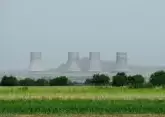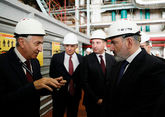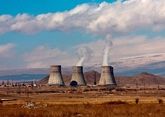An energy crisis may break out in Armenia in the near future: the European Union demanded to close the Metsamor Nuclear Power Plant in Armenia in exchange for cooperation. This demand has already become the subject of a serious public debate, the participants of which were divided into two opposing camps. "To date, there are no alternative sources in Armenia capable of providing one third of the country's electricity needs, provided by the Armenian Nuclear Power Plant, and its closure will lead to weakening of Armenia's positions in the region," Armenian economists claim, discussing the recently published Comprehensive and Extended Partnership Agreement, which Armenia and the European Union are going to sign. At the same time, the most optimistic Armenian analysts are sure that the Armenia-EU agreement will have an absolutely opposite effect for the Armenian nuclear power plant.
Publicist Aram Amatuni assures in his analytical article, published on information portal 1in.am, that the framework agreement does not imply the closure of the Armenian nuclear power plant, and apprehensions in this regard are manipulative, being the goal of anti-integration integration propaganda. Like, the European colleagues are well aware that the nuclear power plant is an object of strategic importance, and apart from the economic and energy mission, it has military and political significance, thanks to which an unwritten consensus has been reached between Armenia and the EU in the form of a certain formula: Armenia will decommission the nuclear power plant only after construction equivalent energy capacities. "This consensus between Armenia and the EU has existed for many years, and the lifetime of the ANPP has been extended once under these conditions, and the EU's request for closure of the nuclear power plant is not what is reflected in the framework agreement. This requirement exists for a long time, just like the above-mentioned consensus between the European Union and Armenia," Amatuni assures.
The expert agrees that the calls for closure of the Armenian NPP, which are periodically heard in Turkey and Azerbaijan, are reasonable, however, he is confident that when it comes to Armenia-EU relations, the closure of the nuclear power plant is more declaratory and conditioned by exclusively standards of the European energy policy. These standards lead to the need of removing of the Armenian NPP from operation, because it does not meet the high modern requirements of the European energy policy.

On the other hand, the Armenian nuclear power plant meets the minimum safety requirements of such structures and poses no danger in terms of operation. Pessimists think differently: publicist Daniel Ioannisyan writes in the article on information portal 1in.am that "it is obvious that no nuclear power plant can operate forever, and it has long been known that the Metsamor nuclear power plant will be closed in 2026."
He confirms his statement with weighty arguments: "Although the reactor of the Armenian NPP was designed in the late 1960s and 1970s and has no specific expiration date, In Metsamor the oldest version of this series, the VVER-440/230 seismic-stable modification has been deployed, while more modern similar power units were also installed at the Novovoronezh NPP (Russia), Kola NPP (Russia), Kozloduy NPP(Bulgaria), Greifswald NPP (Germany) and Bohunice NPP (Slovakia).
Germany removed VVER-440/230 from service in 1990, Bulgaria did it in 2006, and Slovakia in 2008. In Russia one of the two VVER-440/230 power units of the Novovoronezh nuclear power plant was closed in 2016, the other will be closed in 2017, and the two power units of this type at the Kola nuclear power plant will be closed in 2018 and 2019," Ioannisyan writes. It is obvious that in two years the Armenian nuclear power plant will probably become the only nuclear power plant, where the power unit of VVER-440/230 generation will still be functioning. There is no mechanism that will work forever. If the nuclear power plant is concerned, its disruption may endanger health of millions of people and lead to emptying of almost the entire territory of Armenia. And for its exploitation 100% confidence is needed that the reactor will survive under these conditions. Even little doubt or lack of trust are the basis to close the nuclear power plant. Today there is no study to say whether Metsamor Nuclear Power Plant can be exploited after 2026, but, given the fact that the power units of VVER-440/230 generation are already completely decommissioned, it can be assumed that their safe operation date expires.

But as for the energy crisis, it seems that it cannot be avoided: the Armenian NPP now supplies about 1/3 of the electricity consumed in Armenia at the price about 3-4 times cheaper than thermal power plants. If the nuclear power plant is replaced by wind, solar or natural gas power plants, the cost of electricity in Armenia will increase by about 10 drams. At the same time, the construction of a new nuclear power plant is also costly - it is estimated at about $5 billion, and in addition to the fact that such costs are simply unaffordable for the country, the inclusion of the construction into the electricity price will also lead to the increase in tariffs. In other words, the inevitable closure of the Metsamor Nuclear Power Plant would lead to increase in the electricity tariff with all its consequences in any scenario. Armenia's authorities will try to do their best to extend this perspective, but it is unacceptable to do so at the expense of security, Armenian economists are confident.
But what are the realities? Russian nuclear power engineers assure that the Armenian nuclear power plant will be able to work for at least another 25 years: everything depends on the main equipment that is to be replaced, the chief specialist of the nuclear fuel development and engineering services department of Rosatom's TVEL Fuel Company, Vladimir Filippov, believes. "Extension can take place in different ways, and 10 years is not a limit. The approach to extension is always individual, certain investigations are held for each station. But to date, there is an experience of prolonging the service life of a station with a similar unit for 25 years,"Filippov said. Since the construction of the station, there are so-called 'pilot joints' there. The expert retrieves a pilot joint, examines it - how fragile the material has become, what physical changes it has undergone, and if their parameters allow, the extension is carried out on the condition that the full security. "Based on these studies, they concludes how long the station's operation can be extended. The decision to extend the lifetime is made only after having certified that the material retains the properties required for operation," Filippov said, noting that it does not matter for how long and which station is involved, the approach to the validation is the same. Unlike the launch of a new station, it's much cheaper and easier," the expert added.










